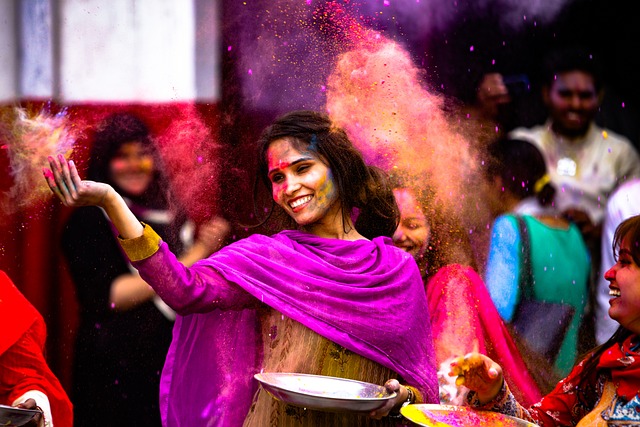
Indian culture and traditions are something that has now become famous all over the world. We all consider the customs and traditions of India to be very diverse and unique. But rarely do we consider why things are done in certain ways. Indian culture is full of many unique customs and traditions that outsiders may find interesting. Most of these originate from ancient Indian scriptures and texts, which have determined the way of life in India for thousands of years. Almost all Indian culture and traditions are based on science, there is a special reason hidden behind every tradition. Therefore the Vedas and Shastras are compared with today’s science. Here are some Unique Indian Culture and Traditions:
Greeting – Namaste

Namaste is one of the most popular Indian customs and is no longer limited to the Indian region only. We have seen even the American President saying Namaste as per Indian culture many times on different occasions. Also, there was UN Secretary-General Ban Ki-moon, who greeted everyone with Namaste in New York’s Times Square on the first International Yoga Day. After the Bharatiya Janata Party came to power, the respect of Indians in the world increased further.
Read More: Sacred Trees, Plants and Fruit in Hindu Culture
What Is The Importance Of Saying Namaste?
Namaste, or Namaskar, or ‘Namaskar’ is one of the five forms of traditional greetings described in the ancient Hindu scriptures, the Vedas. It translates to ‘I bow to you’, and greeting each other with it is a way of saying ‘let our minds meet’, indicated by palms folded in front of the chest. The word Namah can also be translated as ‘Na Ma’ (not mine), indicating the lack of one’s ego in the presence of another.
Festivals and Religions

There are many festivals from time to time in India like Raksha Bandhan, Bhai Dooj, Nagpanchami, Ganesh Utsav, Navratri, Diwali, Makarsankranti, Shivratri, Holi etc. As a consequence of both the Islamic invasion and British rule in India spanning 300-400 years, the Sanatan culture of Hinduism experienced significant division. Over time, the population grew, leading to the fragmentation of religions. Consequently, festivals began to be observed across various religious communities.
Reasons Behind Celebrating Festivals And Festivals
This festival is an expressive way of celebrating the glorious heritage, culture, and traditions. They are there to enjoy the special moments and emotions in our lives with our loved ones. They play a vital role in adding structure to our social lives and connecting us to our families and backgrounds.
Read More: The 11 Most Sacred Rivers of India
Joint Family Structure

India is the country in the world where the largest number of joint families live. Here the concept of a joint family exists, in which the entire family (parents, wife, children, and in some cases, relatives) all live together. This is mostly due to the cohesive nature of the Indian society, and also reportedly helps in dealing with pressure and stress.
Benefits Of Joint Family
There is always an atmosphere of happiness in the house when the whole family stays together. Life becomes stress-free, and financial and mental support is provided. And if the joint family lives in the villages then it is a different matter. By living together, children remain disciplined; apart from this, they also gain knowledge of moral responsibilities quickly. In today’s time, everyone lives a stressful life away from their parents after getting an education.
Read More: Therapy in Nature: 8 Mental Health Benefits of Nature Exposure
Fasting And Worship
Fasting is an integral part of Hindu culture. Fasting or fasting or fasting is a way of representing your sincerity and resolve or expressing your gratitude to the gods and goddesses. People across the country observe fast during various religious occasions. Some people also observe fast on different days of the week in favor of a particular god or goddess associated with that particular day.
The prevailing belief is that by abstaining from this practice, you are denying your body a fundamental requirement.

The origin of fasting probably goes back to the Vedic ritual of lighting the sacrificial fire for sacrificial purposes. Given that the term ‘Upvas‘ is employed to signify both a fast and a sacrificial fire, it may evoke the image of a time when individuals had to ignite or rekindle the domestic fires within their homes to engage in the daily yagya rituals. If so, people fast.
Benefits of fasting
Most types of fasts are done for 24-72 hours. Intermittent fasting, on the other hand, involves cycling between periods of eating and fasting, ranging from a few hours to a few days at a time. Fasting has many health benefits, from diabetes and weight loss to better brain function.
Religious Customs – Sacred Cattle Cow

The cow is considered a sacred animal in Indian culture. She is worshiped as a maternal figure and is a depiction of the generosity of Mother Earth. Lord Krishna, who grew up as a cow herder, is often shown dancing among the cows and Gopis (milkmaids) playing his flute. Interestingly, Lord Krishna is not known as ‘Govinda’ or ‘Gopal’. Also known as Gram, which means ‘friend and protector of the cow’. Therefore, cows have auspicious significance in Indian culture and religion.
The Reason Behind Worshiping The Cow
Even the trusted vehicle of Lord Shiva is Nandi – the sacred bull. Thus, feeding a cow or contributing to cowsheds is of immense religious significance for Indians. In the Vedic scriptures, in various verses, the need to protect and take care of cows is emphasized. Cows are the source of life-giving milk. Even cow dung is an essential and energy-efficient source of fuel, especially in rural India. Killing a cow or eating cow meat is considered a sin. Therefore, many states in India have banned the slaughter of cows by law. However, Mother Cow is not worshiped as other deities. The religion and culture of India express its appreciation and gratitude to this innocent animal that gives back more and more to the earth and its people.
Science Hidden Behind Temples
Most temples are located along the Earth’s magnetic wave lines, which help maximize the positive energy available. The copper plate buried beneath the main idol (called the sanctum sanctorum or Moolasthan) absorbs and resonates this energy with its surroundings. Visiting a temple often helps in attaining a positive mind and positive energy, which leads to healthy functioning.

There is also a practice of removing shoes before entering places of worship as they will bring dirt into an otherwise clean and sacred environment.
Read More: 5 Elements of Nature and Their Relation With the Human Body
Arranged Marriage System

The concept of arranged marriage in India traces its origins back to the Vedic period. Royal families traditionally conduct a ceremony called ‘Swayambar’ for the bride. In this event, eligible matches from the kingdom are either invited to participate in a competition to win the bride, or the bride herself has the privilege of choosing her ideal husband. Even today, the concept of arranged marriage remains a favorite among Indians and is an integral part of ‘Indian traditions’.
Religious and Cultural Symbols
There are various signs and symbols in Indian traditions and scriptures that have many meanings. For example, the use of the Swastika in the Indian context does not point to Adolf Hitler or Nazism. It symbolizes Lord Ganesha who removes obstacles. The arms of the Swastika have different meanings. They represent the four Vedas, the four constellations, or the four primary objectives of human pursuit.

In India, the saying ‘Atithi Devo Bhava’ is also integral. It means ‘Guest is like God’. It is a Sanskrit word taken from the Hindu scriptures, which later ‘became part of the Hindu society as guest has always been of supreme importance in the culture of India.
Read More: How Does Nature Impact Our Wellbeing
Indian Clothing and Clothing
Indian women are often seen wearing ‘sari’. A saree is a single cloth and does not need stitching; It is easy to make and comfortable to wear, and also follows religious etiquette. It initially started as a Hindu tradition but has spread beautifully across all religions. The same applies to the more functional ‘kurta-pajama’ and the formal wear of ‘sherwani’ for Indian men of all religions.




